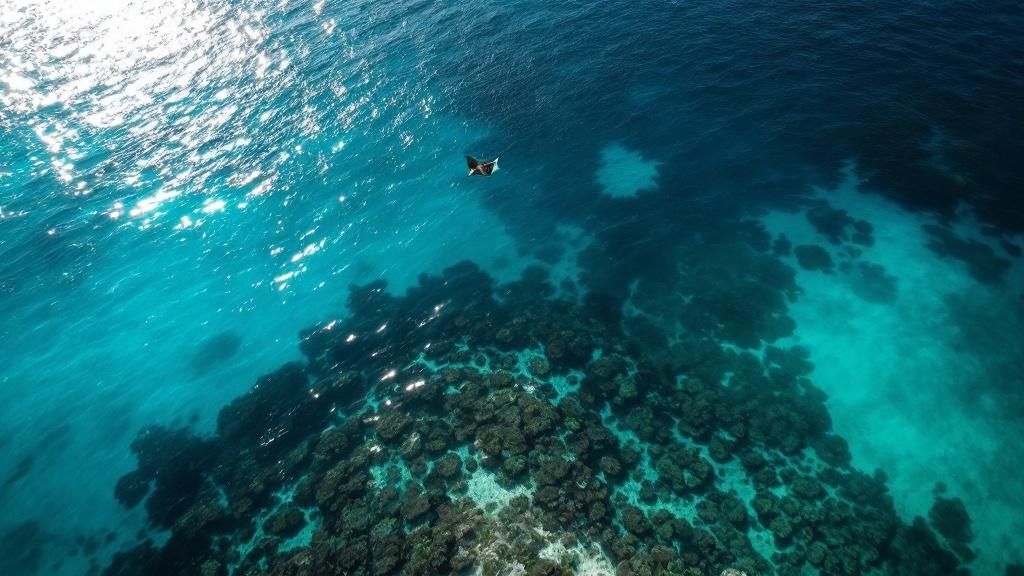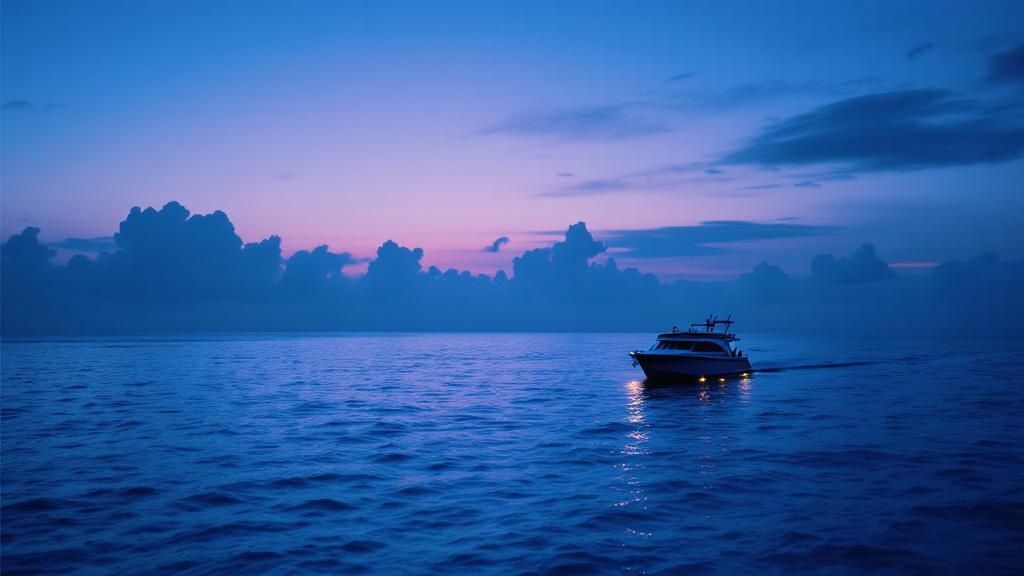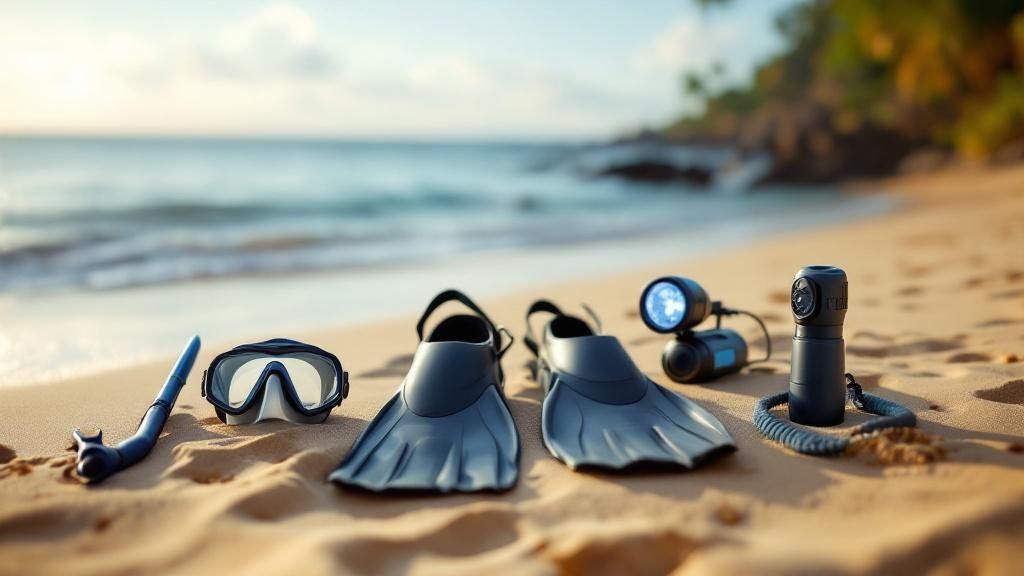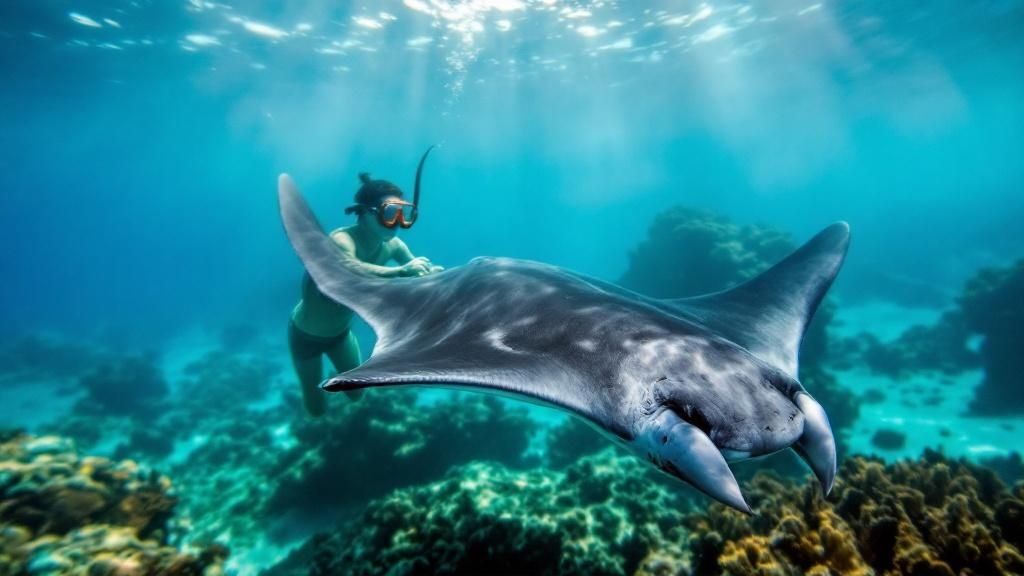Master Manta Ray Snorkel Kona Adventures: Insider Guide
- Byron
- Jun 12
- 13 min read
Why Kona Creates Magic for Manta Ray Encounters
Let me tell you a secret, something most travel guides gloss over: Kona isn't just another pretty face in the snorkeling world. It's manta ray central! After chatting with marine biologists who’ve practically lived in these waters for decades, I learned Kona’s coastline is like a five-star resort for these gentle giants.
The volcanic landscape creates something called thermal layers in the water, along with some really unique current patterns. These currents essentially funnel plankton, the manta ray's favorite snack, into predictable areas. It's like setting up a buffet table right where they like to hang out.
And here’s where it gets even cooler. The resort lights along the coast, although unintentional, actually amplify this effect. Shining into the water, they attract even more plankton, creating these amazing feeding stations for the mantas. It’s like someone flipped on a giant underwater spotlight over the buffet! This bizarre combo of natural and artificial factors has turned Kona into a living laboratory for researchers studying manta ray behavior.
The shallow bays along the Kona coast provide the perfect sanctuary. Protected from predators and rough currents, these areas become calm, nutrient-rich havens where plankton can thrive. The geography of the area also creates the perfect water temperature – nice and stable and warm, just the way manta rays like it. It's easy to see why researchers call this area a hotspot for manta ray activity.
Manta ray snorkeling in Kona has become world-famous, drawing in roughly 80,000 people every year. And the best part? The sighting rate is incredible! We’re talking 80% to 90% success, which means about 8 to 9 out of 10 snorkelers get to witness these majestic creatures in their natural habitat. Pretty impressive, right? Discover more insights on manta ray sightings.
What's more, Kona's success with manta ray tourism has sparked some seriously important conservation efforts. Local authorities and tour operators have teamed up to create sustainable practices that protect both the manta rays and their underwater home. This includes rules about boat traffic, lighting, and how snorkelers should behave. Kona’s now a role model for responsible wildlife tourism around the globe, making sure future generations can experience the magic of these gentle giants.
Finding Your Perfect Manta Ray Snorkel Spot
Picking the right manta ray snorkel spot in Kona can make or break your trip. Trust me, I’ve chatted with guides who’ve spent over twenty years on these waters, and they’ve spilled the beans on the best (and worst) locations. Some spots are perfect for beginners, with calm, shallow water, while others are better suited for more experienced snorkelers looking for a bit of an adventure.
Knowing the water depth at each location is more important than you might think, especially if you're new to snorkeling or prefer calmer conditions. And here’s a fun fact: resort lighting plays a huge role! The lights attract plankton, which then brings in the manta rays for a feeding frenzy. Knowing where the brightest lights are can help you predict where the mantas will gather. Interested in checking out some pre-arranged tours? Here's a resource that might help: 6 Best Manta Ray Snorkel Kona Tours in 2025
Understanding Location Nuances
Every snorkel spot has its own unique characteristics that affect everything from how crowded it gets to the overall vibe. Some locations are easier to access than others, which is particularly important if you have any mobility issues. Even the time of year can impact water conditions and manta ray behavior. Knowing these nuances can dramatically improve your experience.
The Kona Coast offers several prime locations for manta ray snorkeling, including Manta Village and Manta Heaven. Manta Village (also known as Garden Eel Cove) is incredibly popular because it's relatively shallow, usually around 30-40 feet deep. This makes it great for all skill levels. Plus, the resort lights in this area have created a major feeding spot, as the plankton they attract draw in the manta rays. For more on these locations, check this out: Learn more about the locations here.

Key Factors to Consider
Here’s a quick rundown of things to consider when choosing your manta ray snorkel spot:
Your Comfort Level: Are you a seasoned pro or just starting out? Some locations have stronger currents or deeper water.
Crowd Tolerance: Prefer a more private experience? Or do you not mind a bigger group?
Accessibility: How easy is it to get in and out of the water? This is particularly important if you have any physical limitations.
Time of Year: Manta ray activity and water conditions change with the seasons. Do a little research to find the best time to visit your chosen spot.
To help you make the best choice, I’ve put together a handy comparison table of the most popular spots. It breaks down the key differences so you can see at a glance which location is the best fit for you.
Kona Manta Ray Snorkel Locations Comparison
A detailed comparison of the main manta ray snorkeling locations around Kona, including depth, accessibility, and experience type.
Location | Average Depth | Skill Level | Water Conditions | Crowd Level | Best For |
|---|---|---|---|---|---|
Manta Village (Garden Eel Cove) | 30-40 ft | Beginner to Intermediate | Typically calm | High | Families, first-timers |
Manta Heaven | 40-50 ft | Intermediate | Can be choppy | Moderate | Experienced snorkelers, photographers |
Airport Beach | 15-25 ft | Beginner | Usually calm | Moderate to High | Beginners, families with young children |
Keauhou Bay | 20-30 ft | Beginner to Intermediate | Generally calm | Moderate | All skill levels |
Kohanaiki (Private access required) | Varies | Intermediate to Advanced | Can be unpredictable | Low | Experienced snorkelers, seeking seclusion |
As you can see, each location offers a unique snorkeling experience. Manta Village is a classic choice for its accessibility and consistent manta ray sightings, while Manta Heaven offers a slightly deeper and potentially more adventurous experience. For beginners or families with young children, Airport Beach or Keauhou Bay might be more suitable due to their shallower depths and calmer conditions. And for those seeking a more exclusive and less crowded experience, Kohanaiki (if you can get access) is a fantastic option.
By considering these factors and understanding the nuances of each location, you'll be well-equipped to choose the perfect spot for an unforgettable manta ray encounter.
Choosing Tour Operators Who Actually Care
Picking the right tour operator can make or break your manta ray snorkel experience in Kona. Seriously, the difference is night and day. I've been on packed boats with guides who seemed like they were just going through the motions, and I've been on small, intimate tours led by passionate marine biologists who made it a truly educational adventure. Trust me, the latter is what you want.
So, how do you find those responsible operators? One good starting point is looking at those who specialize in smaller groups. Tasmania small group tours offer a great example of this kind of personalized experience, where you get more attention from the guides and they demonstrate a deeper respect for the marine environment. That’s the kind of ethos you should be looking for in Kona.
Certifications and Red Flags
Don't be fooled by flashy websites and marketing hype. Instead, focus on the things that truly matter: experience and certifications. A lifeguard certification is non-negotiable – it shows the operator takes safety seriously. You also want guides with deep knowledge of manta ray behavior and the Kona ecosystem. Their passion is infectious and makes the tour so much more enriching.
Here's a big one: be wary of operators who “guarantee” sightings. Manta rays are wild animals; nobody can predict their movements. Anyone guaranteeing sightings is probably more concerned with selling tours than providing an authentic experience. Another red flag? Overcrowded boats. This often means the operator prioritizes profit over the quality of your encounter.
Boat Size Matters
The size of the boat significantly impacts your manta ray adventure. Smaller boats create a more personal and intimate experience. Larger boats might have amenities like restrooms, but they can also feel impersonal and lead to overcrowding at the snorkel site. Too many people in the water can stress the manta rays and make it harder to enjoy your time with them. Think about what’s important to you: a cozy, small-group vibe or a larger, more party-like atmosphere.
Guides Who Know Their Stuff
The best manta ray guides are so much more than boat drivers; they're marine experts and storytellers. They’ll share fascinating insights about manta ray behavior, the local ecosystem, and the importance of conservation. Find guides who are truly passionate about these gentle giants and eager to share their knowledge. They'll point out subtle manta ray communication cues and interesting behaviors you might otherwise miss.
Adaptability is Key
Ocean conditions can change in a heartbeat. A good tour operator will adapt to those changes, prioritizing everyone’s safety and still working to give you the best possible encounter. Rigid schedules and a one-size-fits-all approach show a lack of flexibility, suggesting the operator values efficiency over your experience. Look for operators who check weather patterns, water clarity, and manta ray activity to determine the best location and timing for each tour.

Preparing For Night Snorkel Success
The magic of a manta ray night snorkel in Kona happens after dark, which definitely adds a unique twist. Having seen tons of first-timers take the plunge, I know success boils down to managing your physical and mental state. So let's break down some practical tips to make your night snorkel smooth and unforgettable.
What to Eat (And Avoid) Before Your Tour
A light meal a few hours before you head out is the sweet spot. Think easy-to-digest foods like fruit, salads, or a simple sandwich. Steer clear of heavy, greasy meals that could leave you feeling sluggish or a bit queasy, especially with the boat rocking gently. Speaking of queasy, motion sickness can seriously put a damper on the fun. If you're prone to it, pop some non-drowsy motion sickness medication about an hour before you leave. Seriously, an ounce of prevention is worth a pound of cure.
Essential Items Most People Forget
While tour operators like Manta Ray Dives of Hawaii will hook you up with wetsuits and basic snorkel gear, there are a few little things that can make a big difference in your comfort. A light sweater is a must for the boat ride back – you'll cool down after being in the water. A quick-drying towel is a lifesaver, and a change of clothes is never a bad idea. For more tips on relaxing and enjoying the Hawaiian spirit, check out the Aloha Relax Blog. It's a great resource for all things chill.
Conquering The Darkness
Night snorkeling is a whole different ballgame compared to daytime adventures. It's perfectly normal to feel a little apprehensive about what's lurking beneath the surface when you can't see clearly. But remember, you'll have experienced guides right there with you, and the lights will illuminate the manta rays beautifully. Focus on slow, deep breaths to stay calm and centered in the water. It's all about enjoying the experience. For even more tips on planning your manta ray adventure, take a look at our Kona Snorkel Guide.
Positioning For Optimal Viewing
You don't need to be Michael Phelps to enjoy manta ray snorkeling. Actually, staying relatively still often gives you the best views. Position yourself near the light source (without blocking it, of course), since that's where the plankton, and therefore the manta rays, will gather. Think of yourself as having a front-row seat to a mesmerizing underwater ballet.
Reading The Water
Water conditions play a role in how the manta rays behave. Calm, clear water is the dream scenario for the best visibility. If it's choppy or murky, the manta rays might be less active or harder to spot. Your guides are pros at reading the water and will pick the best spot based on the conditions. They'll also fill you in on how water temperature and currents influence where the manta rays decide to feed.
Dealing With Cooler Temperatures
Even in Kona, the water can get a bit chilly at night. A well-fitting wetsuit is key for staying warm and toasty. If you're someone who gets cold easily, consider layering a thin rash guard or dive skin under your wetsuit for extra insulation. Trust me, it makes a huge difference in your overall comfort and enjoyment. A comfortable snorkeler is a happy snorkeler!
Maximizing Your Time With Manta Rays
So, you're ready for a manta ray night snorkel in Kona? Amazing! Knowing how to act around these gentle giants is everything. It’s the difference between a quick hello and a truly special experience. After years of watching snorkelers and mantas interact, I’ve learned what brings them closer… and what sends them swimming away.
Positioning For the Perfect View
First up: where to be. You want the best seat in the house for the manta ray feeding show, but you don't want to be the show. The key is to find a spot near the light source. That’s where the plankton gathers—the manta rays' dinner bell. But don't block the light itself. Think of yourself as an audience member, not a performer. Staying relatively still is often more effective than chasing the mantas. They’re curious and often approach calm observers.
Often, the mantas will perform a mesmerizing underwater ballet as they feed.
Understanding The Underwater Choreography
Manta ray feeding is a beautiful thing to watch. They do these graceful barrel rolls and backflips while filtering plankton. Understanding this helps you predict their next move and position yourself perfectly. It’s like knowing the steps to a dance—you'll be in the right spot at the right time. Years of data collection in Kona, tracking individual manta rays and their behavior from 2009-2014, has taught us so much about these incredible creatures. You can learn more about this research here.
Photography Tips For Low-Light Conditions
Taking pictures in low light can be tough. Even a smartphone can get decent shots if you keep it steady and skip the flash. Flash can scare the manta rays and mess up their feeding. A GoPro or other underwater camera is even better! Just attach it securely to a float or wrist strap so you don’t lose it in the excitement.
Reading Manta Ray Body Language
Manta rays have subtle ways of communicating. Relaxed mantas glide smoothly, cephalic fins (those horn-like things on their heads) unfurled. If they start swimming erratically or curl their cephalic fins in, they might need a little space. Like with any wild animal, respecting their boundaries is essential.
Patience Is Key: Extending Your Encounters
The longer you stay still and watch, the better your chances of a close encounter. Resist the urge to swim closer. Patience pays off. The mantas might come so close you can see the patterns on their undersides. Trust me, it’s magical. It’s worth the wait.

Smart Booking Strategies That Work

Let's talk manta ray night snorkels in Kona. Booking smart can make all the difference between an unforgettable experience and a real letdown, especially during peak season. Knowing the when and how can seriously up your chances of having an amazing time. I’ve helped tons of people plan their Kona trips, and I'm happy to share some tips that consistently lead to better experiences and sometimes even better deals.
Seasonal Secrets and Crowd Patterns
Manta rays, like many wild animals, follow seasonal patterns. Kona has mantas year-round, but certain times of year are better for your wallet and your sanity. The shoulder seasons (spring and fall) often have plenty of manta ray action but fewer people than the summer months. This can translate to lower prices and more tour availability. You might even find fantastic manta encounters in the “off-season” with way less competition for the best viewing spots.
For some more specific insights on picking the right manta ray snorkel tour in Kona in 2025, check out this article: best manta ray snorkel kona tours in 2025.
Decoding Package Deals and Local Connections
Package deals look tempting, right? Sometimes they're a great deal, but not always. Don’t just fall for the marketing hype; actually crunch the numbers. You might find that booking things like your hotel and tours separately actually saves you money. Also, tapping into local knowledge can sometimes unlock amazing experiences. Chatting with the hotel concierge or local dive shops can sometimes reveal insider deals or point you towards smaller, more personalized tours.
Weather Worries and Guarantee Policies
Kona’s weather has a mind of its own. A backup plan is crucial. Make sure you understand the tour operator's cancellation policy. Most reputable ones offer rescheduling options or refunds if the weather doesn’t cooperate. Those “manta ray guarantees” are often just marketing fluff. They sound nice, but most operators already have really high sighting rates (around 90%), so the guarantee isn't usually that special. Instead, look for operators with flexible rescheduling and a strong track record.
Timing is Everything: Jet Lag and Energy Levels
Think about your energy levels when booking. Manta ray night snorkels usually happen after sunset. If you’re fighting jet lag, a later departure might be a better choice than rushing straight from the airport. Also, consider how your manta ray adventure fits into your overall itinerary. Don’t sandwich it between two exhausting activities. Give yourself time to relax and truly appreciate the experience.
Handling Last-Minute Changes
Travel plans can change in a heartbeat. A good operator gets that. Ask about their change policies. Can you adjust your booking date or time without losing money? Knowing this beforehand can prevent headaches and save your deposit. Keeping the lines of communication open with your tour operator is key to handling any unexpected hiccups.
To help you visualize the best time to book, I've put together a handy table:
Manta Ray Tour Booking Calendar Monthly breakdown of optimal booking times, seasonal considerations, and what to expect throughout the year
Month | Manta Activity | Weather Conditions | Crowd Level | Booking Recommendation | Average Price Range |
|---|---|---|---|---|---|
January | High | Variable | Moderate | Book in advance | $100 - $150 |
February | High | Variable | Moderate | Book in advance | $100 - $150 |
March | High | Improving | Moderate | Book in advance | $100 - $150 |
April | High | Good | Lower | Consider booking soon | $90 - $140 |
May | High | Good | Lower | Consider booking soon | $90 - $140 |
June | High | Excellent | High | Book well in advance | $110 - $160 |
July | High | Excellent | High | Book well in advance | $110 - $160 |
August | High | Excellent | High | Book well in advance | $110 - $160 |
September | High | Good | Lower | Consider booking soon | $90 - $140 |
October | High | Good | Lower | Consider booking soon | $90 - $140 |
November | High | Variable | Moderate | Book in advance | $100 - $150 |
December | High | Variable | Moderate | Book in advance | $100 - $150 |
This table gives you a general overview, but remember that conditions can vary. Use this as a starting point and always check with your chosen tour operator for the most up-to-date information.
Your Kona Manta Ray Adventure Awaits
Every manta ray encounter in Kona is unique. With a little planning, yours can be truly special. We'll cover everything from picking the perfect spot for your comfort level to finding a responsible tour operator who cares about your experience and marine conservation.
This isn't just about checking off a bucket list item. It's about connecting with some of the ocean's most graceful and intelligent creatures. Trust me, the memories you make during a manta ray snorkel in Kona will probably change the way you think about ocean exploration and marine conservation.
Protecting the ocean is vital for these amazing animals. If you're interested in learning more about how you can help, check out this article on preventing marine pollution.
Making Your Experience Unforgettable
Don't rush the planning process. Take your time to choose a tour operator based on their reputation and experience, not just the price tag. Remember, it's about respecting these incredible animals and the delicate Kona ecosystem that makes these encounters possible.
Your Kona manta ray adventure is out there, waiting for you. Now you've got the inside scoop to make it absolutely unforgettable. Ready to dive in? Book your Manta Ray Night Snorkel Hawaii adventure today – you won’t regret it!
Comments